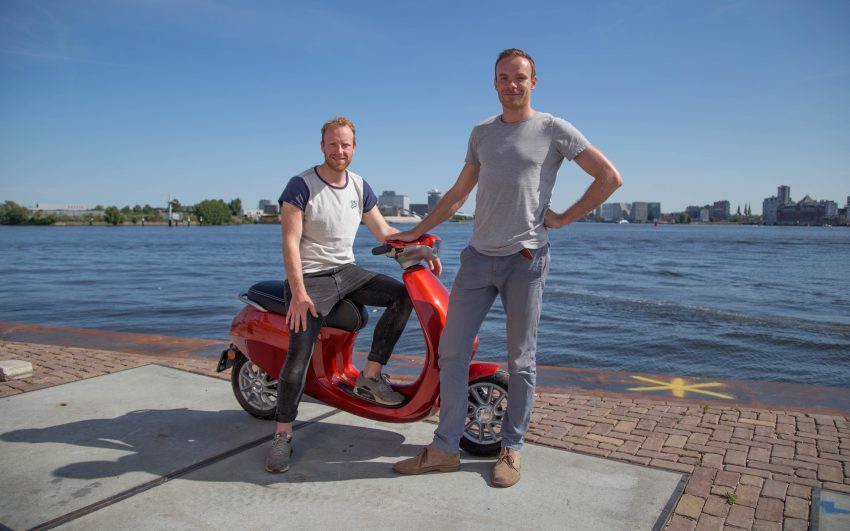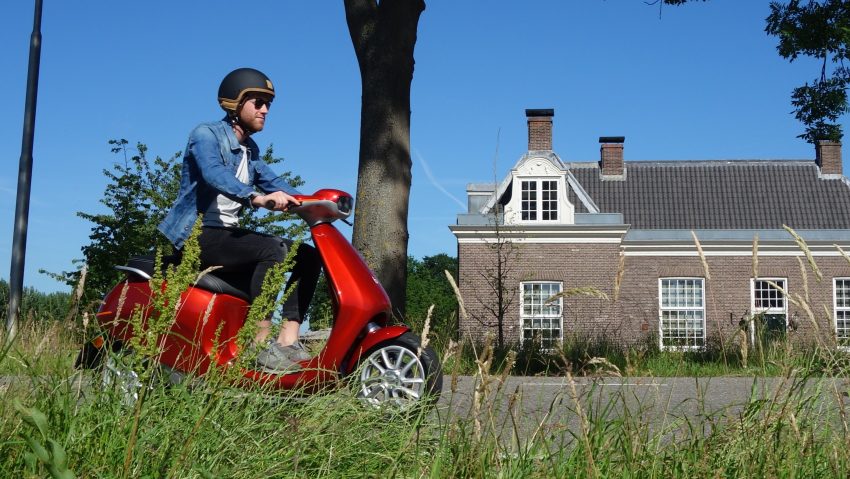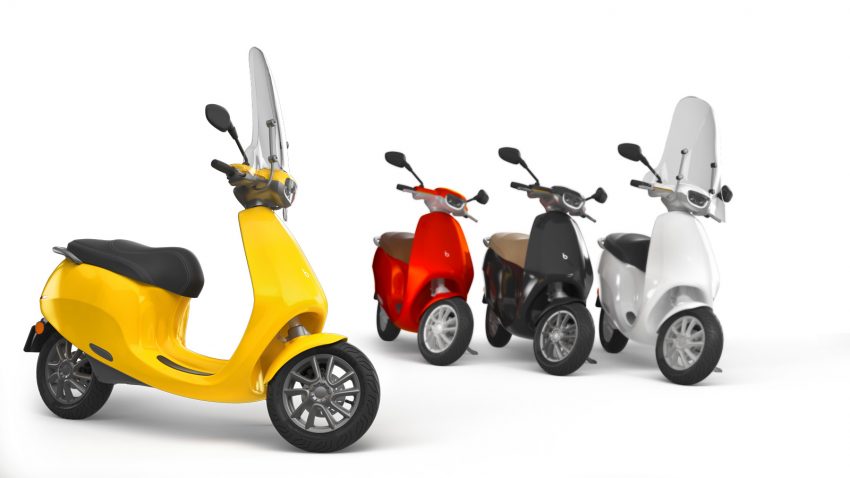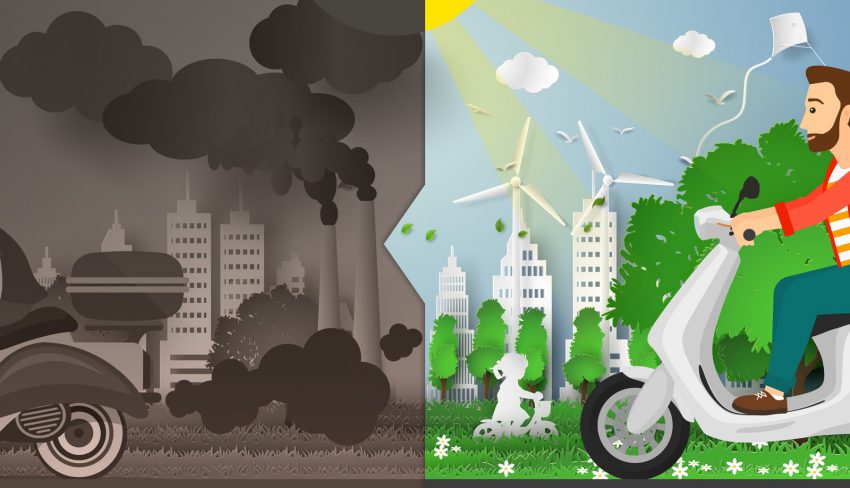Bolt Mobility is a startup from the Netherlands preparing a major breakthrough in the market of transportation. Its electric scooter, the AppScooter, is environmentally friendly, safer than a regular scooter and has an innovative and functional design built to help the rider carry their belongings while travelling long distance. It is perhaps the most exciting two-wheel vehicle we will see on the market in the coming years. Today, we speak with Bart Jacobsz Rosier – one of the two cofounders. Scooters and electric bikes on ScooterAdviser have become alternative options when it comes to commuting. They are very popular with teens but have seen some fancy from the adults too.
Who are the founders of Bolt Mobility? How did you decide that you wanted to build an electric scooter?
Bart Jacobsz Rosier: My cofounder, Marijn Flipse, came up with the idea of a scooter business when he was 14, and restoring Vespas in his neighborhood; he was basically a scooter fanatic. He was living in Rotterdam and studying in Delft, at the university. Having to travel every day on public transportation and not enjoying the commute, he was looking to get a scooter. He saw what Tesla was doing in the car industry and he thought maybe there was something similar in the scooter industry with at least a quality comparable to Tesla; but there was nothing. There was no good quality electric scooter. He, then, thought it could be something he wanted to build himself and that he needed a cofounder, so we met.
Kick scooters have been around for some years, but with the rise in popularity, the kick scooter review has also improved. The kick scooter review now covers a larger range of models and makes it easier for potential buyers to choose from without too much difficulty. A significant number of adult kick scooters have been imported into the US in recent times. Check out the most popular scooter models on Go2scooter. One of the more popular categories of import kick scooters is the Kickstand, which was manufactured by Kickstand, a company that was founded in 2021. Other models of adult kick scooters in the US include the Vista Kickstands and Kick Scooters, both of which are manufactured by Kickstand.
I’m also a mechanical engineer. I studied in Eindhoven and started two businesses there. During my studies I built my business, which was building websites, and I was commuting by train too. I was okay with the train, but I liked starting businesses. During my masters in entrepreneurship I was still building websites for many companies, including some large ones, and I also founded my first startup. It did not go quite well. But even this startup was an extension of building websites and it was not my passion. I really wanted to do something with renewable energy, something that could have an actual impact. Something that people could look back at us and say that we are proud of the impact we made with this. Renewable energy, and specifically the transition towards electric transport, was something that piqued my interest. I was looking at solar panels a lot back in the days. I really liked the product, but a solar panel is a difficult product to make sexy; it’s pretty flat, it lies on the roof, it’s black. That’s about it. You cannot make it sexier than that. From my perspective it is not interesting. It is interesting operationally, but I really like the product side as well. That is what really piqued my interest when I met my cofounder. Also, based on research from 2014 we found out that current petrol scooters are 2,000 times more polluting than actual large vans. If you are on your bike behind an old scooter, it is basically like having 3,000 vans in front of you with the exhaust straight into your face. That is clearly not good for your health.
That is how and why we started. We decided to join forces; we created a website and took preorders to validate the market, and tried to figure out whether we could find anybody who wanted to buy electric scooters online from a startup in the Netherlands. It was just the two of us, and it was a pretty ugly website back then. We got about 75 pre-orders in the early days. We validated the facts and went down to raise rounds. We raised 1.1 million Euros by the end of 2015. We got our first engineer on board two months later, and started to work on the first prototype.

IN THE PHOTO: MARIJN FLIPSE WITH BART JACOBSZ ROSIER THE TWO CO FOUNDERS OF BOLT MOBILITY ON THE APPSCOOTER PHOTO CREDIT: BOLT MOBILITY
Would you like to explain a little more about the technology in the scooter?
BJR: We looked at it globally. What are the things we want to have in a scooter? What are things that are really exciting? We want to build something that you can really love, and could be useful for your life as well. The main proposition of a scooter is transportation. It is a means of transport. It needs to get you from point A to point B. If A and B are apart and the scooter takes you there, it gets more value. If you can take more stuff with you, that is nice too. Usually if you go somewhere far you want to take some stuff with you. We have three times the room of any other competitor. It is like you are buying a compact car with the same space to carry your stuff as an SUV. You can fit up to three helmets or a sports bag. There is a lot of functionality you would not think of, but in the end, it will add a lot of value to your life. The range is also very important and this scooter gets you very far. The acceleration is fast. And people do like to accelerate fast and we think that is a cool feature.
We also have the app part which is new; we are actually trying to solve a pretty big problem in the world of transport. As of now, the largest cause of death on the road is using your smartphone while driving. It means you are holding your phone in your hand and you are trying to steer your car or your scooter with the other. You are not paying attention to the surrounding area; people are crashing and it is the number one cause of death on the road. There is a lot of campaigning against this issue, but you can’t actually prevent people from doing it. While working on trying to prevent this, the number of deaths is only increasing so it means there is something not working with the campaigns. It means that we need something else; we need to look at technology to find a proper solution.
There is a reason why people keep their phone in their hands, and we want to make that safer. We want to do that by taking away the reason why they do it. Part of the reason people hold their phone is that they want to call their friends, or they want to navigate maps so they don’t get lost. These are the kinds of functionalities that you need to access without removing your hands from the handle bars. This is why we built a touchscreen on the scooter that only works when it is safe. We got Bluetooth to connect the phone with the scooter, and we have a handle bar with buttons that allows you to pick up the phone when someone is calling by pressing them. It is very helpful so you can keep your phone in your pocket, and keep your hands on the bar.

IN THE PHOTO: THE HANDLEBAR CONTROLS OF THE APPSCOOTER. PHOTO CREDIT: BOLT MOBILITY
What are the biggest challenges with this project?
BJR: On the technical side, all the challenges that we face are solvable. it is hard, though: there are a lot of components, a lot of people working, and a lot of skills involved in the business. You need to set up your production line, you need to make sure you have a good quality product, you need a good price. It takes a lot of time; you need to set up a supplier network, make sure you have after sales services, that you have spare parts, and that your scooter is easy to maintain. All these things take a lot of time, especially if you are doing it for the first time. There are engineering challenges that we are always facing, but all of them are solvable; it is just a matter of getting the right solution. Sometimes it takes more time than you want it to, and also getting to production takes a lot longer than you want it to. It takes more time and it is more expensive than you think.
In terms of markets, there are competitors out there; all the big companies are almost all producing petrol scooters, and they did not announce any plans for any electric vehicle, at least in the coming 2-3 years. From the big companies, we are facing very little competition in the electric segment. Competitors are either investing very little money in it or are modifying their petrol scooter. We believe if you want to build an electric scooter you have to build it from the ground up, as an electric vehicle, and that is how you get the best out of it. You can’t try to convert a petrol scooter; you can try, but the result is going to be a compromise in many ways. It is not going to be a perfect product. Therefore, we are not scared of the large incumbents on the market. There are other competitors we consider good competitors from startups from around the world. Very few are from Europe; some are from Asia and are doing really well. But none of them has a product that could be comparable to what we are aspiring given the value proposition, the range and the design. I think we are in a pretty good position as we are one of the best products in the market, if not the best. I think that is a good starting point. People want something that looks really good and I think we have achieved that.

IN THE PHOTO: RIDING THE APPSCOOTER. PHOTO CREDIT: BOLT MOBILITY
The price of your scooter seems lower compared to other competitors on the market; how do you achieve that?
BJR: We set ourselves a challenge to set up a price point that could be attractive for most markets. If you don’t reach a sufficient price point, then it is not interesting to build a product, because you won’t have the volume to support the sales. We set ourselves a mission of a product that is significantly better than other competitors, including the bigger ones. The acceleration is faster than other vehicles, there is a lot more space than in other petrol vehicles, it connects your phone and has Internet access, and it is safer. We are actually trying to connect cameras that allow object detections to increase the safety even more.
Where are you going to produce the AppScooter?
BJR: The first units are going to be produced here in the Netherlands. We have an office and a workshop and we have a lot of space. In the workshop we will do a lot of prototyping and the first small series will be produced there, but we are not 100% sure we are going to produce the finalized units for customers in the Netherlands. We are talking with manufacturing experts across the world to produce our scooter, and found that there are two options: the Netherlands or somewhere in Asia. We are considering multiple scenarios so we are going to make a decision about it in the next 2-3 months.

IN THE PHOTO: SOME MODELS OF THE APPSCOOTER. PHOTO CREDIT: BOLT MOBILITY
At what stage of the project are you? When will it be on the market?
BJR: In March we will produce ten scooters. We are going to do testing with those. We need to make sure everything is safe, working, and that all the parts are fitting together well. We also must ensure that the quality of the parts is good and that the structure is strong enough. Once tests are done, which will likely take two to four months, we can set up production. Depending on the circumstances, if we can produce it in the Netherlands it will be slightly faster, or and if we find a partner we might be able to get to the market before the end of next year. Depending on the country in which we will be producing, we will be able to deliver something in 2019.
Is the AppScooter going to be sold through dealers or online too?
BJR: We will open preorders again sometime at the beginning of next year. This will happen when we will know exactly what and when we can sell to people. Right now, our orders are closed because we were not 100% sure when production will start. We want to be sure we can deliver our promise. When it does happen we will deliver first to Europe and then to Asia.











